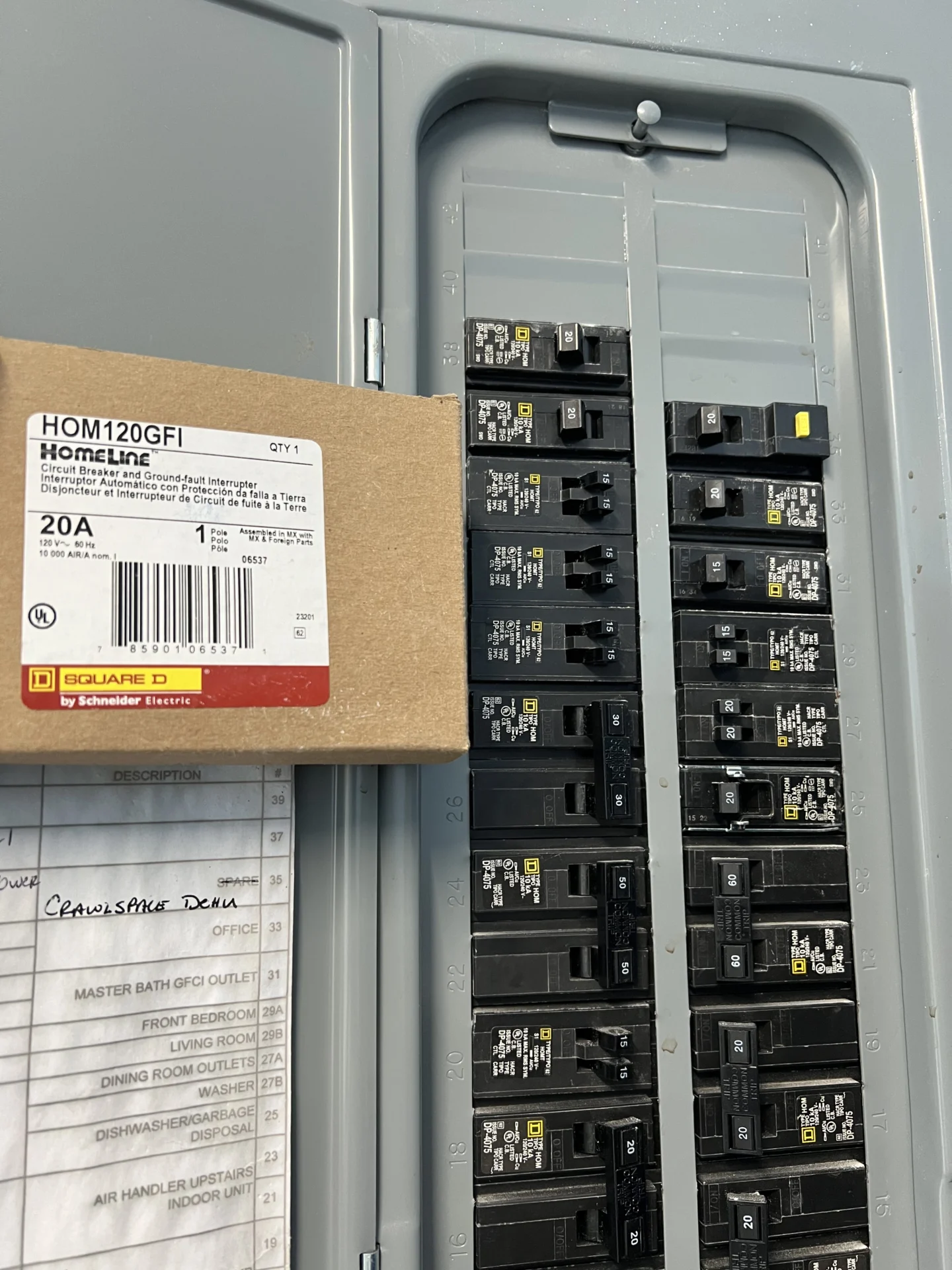Whether upgrading an existing system or installing new circuit breakers for added protection, understanding the importance of circuit breakers and how they work is essential for ensuring the safety and reliability of your home’s electrical infrastructure.
Understanding Circuit Breakers
Circuit breakers are crucial components of your home’s electrical system, designed to protect against electrical overloads and short circuits. They act as automatic switches that trip and interrupt the flow of electricity when abnormal conditions are detected, preventing damage to appliances, wiring, and potential fire hazards.
Key Components
- Breaker Switch: The lever that manually controls the circuit breaker, allowing you to turn it on or off.
- Trip Mechanism: A mechanism automatically trips the breaker when excess current flows through the circuit.
- Contacts: Conductive plates that open and close to interrupt or allow the flow of electricity.
- Bimetallic Strip: A temperature-sensitive strip that bends when heated, triggering the trip mechanism during overload conditions.
- Arc Chute: A device that extinguishes the arc produced when the contacts open, preventing damage to the breaker and surrounding components.
Types of Circuit Breakers
Circuit breakers are essential components of electrical systems, designed to protect against overcurrents and prevent electrical hazards such as fires and electrical shocks. There are several types of circuit breakers, each with specific features and applications:
- Standard Circuit Breakers: Standard circuit breakers, or single-pole breakers, are the most common type used in residential and commercial electrical panels. They protect against overloads and short circuits and are available in various current ratings to accommodate different electrical loads.
- Double-Pole Circuit Breakers: Double-pole circuit breakers, also called two-pole breakers, consist of two single-pole breakers connected to disconnect both hot wires simultaneously in a 240-volt circuit. They are commonly used for large appliances such as electric water heaters, air conditioners, and electric ranges.
- Ground Fault Circuit Interrupters (GFCIs): GFCIs are specialized circuit breakers designed to protect against ground faults. These occur when electrical current leaks from a circuit and flows through unintended paths, such as through water or a person’s body. GFCIs quickly interrupt the circuit to prevent electric shocks and are required in areas where water and electricity may come into contact, such as bathrooms, kitchens, and outdoor outlets.
- Arc Fault Circuit Interrupters (AFCIs): AFCIs are designed to detect and interrupt arcing faults, which can occur when damaged or deteriorated wires create sparks or arcs that could ignite nearby materials. AFCIs help prevent electrical fires by quickly de-energizing the circuit when detecting arcing. They are typically required in bedrooms, living rooms, and other areas with combustible materials.
- Combination Arc Fault Circuit Interrupters (CAFCIs): CAFCIs combine the functions of GFCIs and AFCIs into a single device, providing protection against ground and arcing faults. They are increasingly used in modern electrical installations to enhance safety and comply with building codes.
- Three-Pole Circuit Breakers: Three-pole circuit breakers protect each of the three phases in three-phase electrical systems. Their industrial and commercial uses are common where three-phase power is required.
- Miniature Circuit Breakers (MCBs): MCBs are compact circuit breakers designed for low-voltage electrical systems. These overload and short circuit protectors are used in residential, commercial, and industrial settings applications.
These are some of the main types of circuit breakers used in electrical systems. Each serves a specific purpose and provides essential protection against electrical hazards. Choosing the correct type of circuit breaker for your application depends on factors such as the electrical load, environment, and safety requirements.
Signs You Need New Circuit Breakers
Knowing when to replace your circuit breakers is essential for electrical safety and reliability. Look out for these signs that indicate it’s time for an upgrade:
- Tripped Breakers: If your circuit breakers trip frequently or fail to reset correctly, it could be a sign of overload, short circuits, or worn-out breakers.
- Buzzing or Humming Sounds: Unusual sounds from the circuit breaker panel could indicate loose connections, damaged wiring, or faulty breakers.
- Hot Breakers: If your circuit breakers feel hot to the touch, it could be a sign of overheating due to excessive current flow or poor connections.
- Burning Smells: Burning odors from the circuit breaker panel could indicate overheating or electrical arcing, signaling a potential fire hazard.
- Age: If your circuit breakers are over 20-30, they may no longer provide reliable protection and should be replaced with newer models.
The Installation Process
While DIY electrical work is not recommended, understanding the installation process can help you communicate effectively with your electrician and ensure a smooth and successful installation:
- Assessment: A licensed electrician will assess your home’s electrical system and determine the appropriate type and size of circuit breakers needed for each circuit.
- Preparation: The electrician will shut off power to the affected circuits and carefully remove the old circuit breakers from the panel.
- Installation: The new circuit breakers will be installed in the panel, connected securely, and labeled accurately for easy identification.
- Testing: After installation, the electrician tests each circuit breaker to ensure proper functionality and protection against overloads, short circuits, ground faults, and arcing faults.
- Final Inspection: Before restoring power to the circuits, a final check can confirm that the installation meets all safety and code requirements.
Maintenance and Care
To keep your circuit breakers in optimal condition and ensure their continued reliability, follow these maintenance tips:
- Regularly have a licensed electrician inspect your system for signs of wear, damage, or corrosion and make any necessary repairs or replacements.
- Keep the area around the circuit breaker panel clean and clutter-free to ensure proper ventilation and accessibility.
- Test GFCIs and AFCIs periodically to ensure they function correctly and provide adequate protection against electrical shocks and fires.
- Educate household members about the location and operation of circuit breakers, safety procedures for resetting tripped breakers, and responding to electrical emergencies.
Congratulations! With this information and insight, you can make informed decisions about circuit breaker installations for your home. At The Go-To Crew Electric, we’re committed to providing reliable and professional electrical services to ensure the safety and satisfaction of our customers.
If you’re ready to upgrade your circuit breakers or have any questions, don’t hesitate to contact our team of experts. Let’s safeguard your home together!



